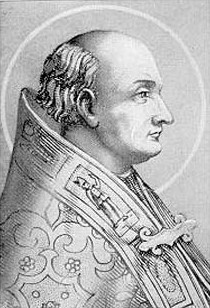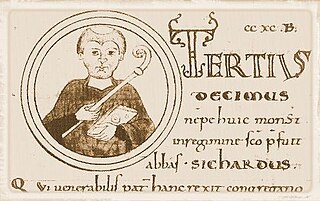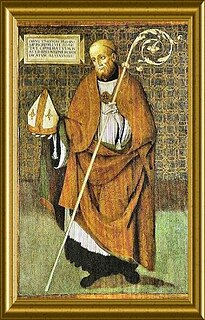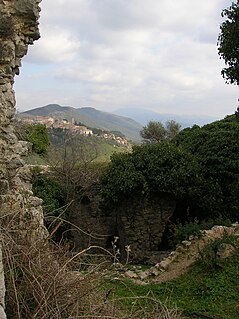Ingoald (died 830) was the Abbot of Farfa from 815, succeeding Benedict. At the beginning of his abbacy he vigorously protested the policies of Pope Leo III (795–816), which had resulted in the abbey's loss of property. Ingoald complained about not only the—illegitimate, as he saw it—seizure of Farfa's lands, but also the application of dubious laws of Roman origin in a zone that followed Lombard law. [1] While Ingoald also fostered close contacts with the Carolingian rulers of Francia and Lombardy, he resisted secular encroachments on the abbey's privileges as staunchly as he resisted papal ones. [2] The rate of property transactions at Farfa seems to have peaked under Ingoald, but the surviving documentary evidence is far from complete. [3]
Benedict was the Abbot of Farfa, Italy from 802 until his death. He is the first abbot mentioned in the eleventh-century history of the abbey written by Gregory of Catino whose origins were not known.

Pope Leo III was pope from 26 December 795 to his death in 816. Protected by Charlemagne from his enemies in Rome, he subsequently strengthened Charlemagne's position by crowning him Holy Roman Emperor and "Augustus of the Romans".

Roman law is the legal system of ancient Rome, including the legal developments spanning over a thousand years of jurisprudence, from the Twelve Tables, to the Corpus Juris Civilis ordered by Eastern Roman Emperor Justinian I. Roman law forms the basic framework for civil law, the most widely used legal system today, and the terms are sometimes used synonymously. The historical importance of Roman law is reflected by the continued use of Latin legal terminology in many legal systems influenced by it, including common law.
In 817 Pope Stephen IV issued a bull claiming that Farfa's lands lay within the Papal patrimonium sabinense (Sabine patrimony) and under Papal ius (jurisdiction), and that therefore the abbey owed the Holy See an annual rent (pensio) of ten gold solidi . Hoping to recover Farfa's lost territories, Ingoald agreed to pay the pensio. When the lands were not returned, he sent a complaint to King Lothair I that the monastery was "constrained under tribute and payment to the Roman pontiffs" and its lands "violently taken away". [4] In 824, on the occasion of the promulgation of the Constitutio Romana , the king and his father, the Emperor Louis I, responded with a privilege for Farfa. In the next pontificate, that of Paschal I (817–24), this claim to an annual rent was withdrawn, but in January 829 Farfa's advocate, Audolf, accused Leo III and the earlier Adrian II of having invaded the monastery's properties with force. By the time of this tribunal, held in the presence of imperial missi dominici and Pope Gregory IV in the Basilica of Saint John Lateran, the complaint of payment had been dropped, so the imperial privilege seems to have had its intended effect. [5] Although Ingoald presented charters from Duke Theodicius of Spoleto and Queen Ansa with confirmations from King Desiderius and Charlemagne, and the tribunal found in Farfa's favour, Gregory IV "refused to do anything" (facere noluit). [6]

Pope Stephen IV was Pope from June 816 to his death in 817.

Lothair I or Lothar I was the Holy Roman Emperor, and the governor of Bavaria (815–817), King of Italy (818–855) and Middle Francia (840–855).
The Constitutio Romana was drawn up between King Lothair I of Italy (818–855), co-emperor with his father, Louis the Pious, since 817, and Pope Eugene II (824–827) and confirmed on 11 November 824. At the time the election of Eugene was being challenged by Zinzinnus, the candidate of the Roman populace. Eugene agreed to several concessions to imperial power in central Italy in return for receiving the military and juridical support of Lothair. The Constitutio was divided into nine articles. It introduced the earliest known Papal Oath, which the Pope-elect was to give to an imperial legate before receiving consecration. It also restored the custom established by Pope Stephen III in 769 whereby both the laity and clergy of Rome would participate in Papal elections.
Ingoald was succeeded by Sichard.

Pope Gregory IV was Pope from October 827 to his death in 844. His pontificate was notable for the papacy’s attempts to intervene in the quarrels between the emperor Louis the Pious and his sons. It also saw the breakup of the Carolingian Empire in 843.

Pope Paschal I was Pope from 25 January 817 to his death in 824.

Subiaco is a town and comune in the Metropolitan City of Rome, in Lazio, central Italy, 40 kilometres (25 mi) from Tivoli alongside the river Aniene. It is a tourist and religious resort thanks to its sacred grotto, in the medieval St Benedict's Abbey, and for the Abbey of Santa Scolastica.

Farfa Abbey is a territorial abbey in northern Lazio, central Italy. It is one of the most famous abbeys of Europe. It belongs to the Benedictine Order and is located about 60 km from Rome, in the commune of Fara Sabina, of which it is also a hamlet.
Theodicius was the Duke of Spoleto from 763 to 773. Though it is often stated that he died at the Siege of Pavia (774), he was still alive on 9 June 776, when Charlemagne confirmed the properties of the monastery of Farfa and Abbot Ingoald in the reign of his successor Hildeprand.

Sichard was a 9th century Italian Monk. He was the Abbot of Farfa from c.830 to 842. His abbacy corresponds with a drop in the number of property transactions involving Farfa, perhaps because "[its] wealth was by that time sufficient to cover major building at the abbey itself." Sichard added an oratory to the existing abbey.

Thomas of Maurienne was the first abbot of the Abbey of Farfa, which he founded between 680 and c.700. Although the sources of his life are much later, and he is surrounded by legends, his historicity is beyond doubt.
Ragambald was the Abbot of Farfa from 781 until his death. According to the abbey's twelfth-century historian Gregory of Catino, Ragambald was born in a city in Gaul (Gallia), that is, Francia, but he does not explicitly call him a Frank. Succeeding Probatus, a local-born abbot, Ragambald was the first of a line of abbots from Francia, including Altpert (786–90) and Mauroald (790–802). The significance of the Frankish presence at Farfa and of Ragambald's abbacy is summed up:
.. . the ‘new’ abbeys of the time not only arose under Frankish influence but also infiltrated the religious life of Lombard Italy with ‘Frankish’ ideas and attitudes, providing a kind of ‘fifth column’ that prepared the way for Frankish military victory and a more ready acceptance of Frankish political domination.
Mauroald was a Frankish monk from Worms and the Abbot of Farfa from 790. Farfa, at less than a century old, was still interested in accruing territories through grants and donations in order to support its building projects and the expansion of its site.

Peter was the long-serving Abbot of Farfa from about 890 until his death. He replaced the interim abbot Vitalis. His abbacy marked the return of stability after a period which saw four abbots in the space of two years.
Lucerius was the third Abbot of Farfa, succeeding Aunepert in 724 at the latest. He was originally from Provence and had been raised at Farfa by Thomas of Maurienne, the first abbot. Lucerius' abbacy was a period of growth and expansion on the part of the abbey. In his first year, he received a grant of a church with its (unspecified) lands from Duke Thrasimund II of Spoleto. This church, dedicated to Saint Getulius, lay within the jurisdiction of the Diocese of Rieti, and according to the tenth-century Exceptio Relationum Thrasimund had to compensate the bishop for his loss.

Fulcoald was the fourth Abbot of Farfa from 740. In 739 King Liutprand granted Farfa the right of freedom in abbatial elections, but we do not know if Fulcoald was the product of such a free election or not. Like his predecessor, Lucerius, Fulcoald hailed from Aquitaine, then in southern Francia. "With his abbacy, the quantity of our [historical] evidence dramatically increases [and d]evelopments in secular politics can now be seen to impinge on Farfa's land acquisitions." Fulcoald's abbacy can therefore be defined in terms of three objectives that are apparent in the surviving sources: (a) to extend its landholdings and secure its rights to its properties, (b) to promote a strict and disciplined monastic observance, and (c) to "steer as untroubled a course as possible through the choppy waters of Italian politics".

Alan was an Aquitanian scholar, hermit and homilist who served as the sixth Abbot of Farfa in central Italy from 761. Before taking over at Farfa, Alan composed the Homiliarium Alani, "one of the most successful homiliaries of the late eighth and early ninth centuries", traces of which may be found in the liturgical formulae scattered throughout Farfa's eighth-century charters.
Perto was the Abbot of Farfa from 854/7 to 872. Between 857 and 859 he received a privilege from the Emperor Louis II confirming a cella called Santa Maria del Mignone. Since this is the first time Santa Maria is mentioned in Farfa's possession it may have been acquired around this time by Perto. Louis's diploma confirmed privileges granted Farfa by his father, Lothair I, in 840. The imperial diploma forbade any financial imposition on Farfa by any pope or secular ruler. This diploma may have been aimed at courting good relations with the pope or it may be associated with Louis's intervention in the Duchy of Spoleto in 860. In 864 Louis confirmed Farfa's possessions and, at the insistence of Bishop Peter of Spoleto, protector of the abbey since 840, made a donation to it in the region of Massa Torana.
John I was the Abbot of Farfa from 871/2. He made a few property acquisitions, but his abbacy comes at the start of an obscure period in Farfa's history. He received a confirmation from the Emperor Louis II of all of Farfa's lands on 27 May 872 and another from Charles the Bald in 875. Charles confirmed the abbey's freedom from taxation and secular jurisdiction and gave its abbots jurisdiction in suits involving subjects of the monastery's lands.
Hugh was the Abbot of Farfa from 998. He founded the abbatial school and wrote its history from the late ninth through the early eleventh century under the title Destructio monasterii Farfensis. A later student of his school, Gregory of Catino, wrote a fuller history of the monastery partly based on Hugh's earlier account.
Probatus was the Abbot of Farfa from 770 until 781, and the first abbot native to the Sabina. He steered the abbey through the fall of the Kingdom of the Lombards, trying to prevent the disastrous aggression of its last king, and kept it from falling under the jurisdiction of either the Papacy or the Papal States. With the benefit of his local connections he oversaw a great expansion of the abbey's properties through grants and purchases, and also rationalised its holdings to create a robust base for an early medieval monastic community.

Gregory of Catino was a monk of the Abbey of Farfa and "one of the most accomplished monastic historians of his age." Gregory died shortly after 1130, possibly in 1133.













